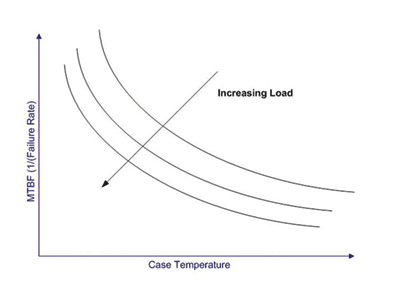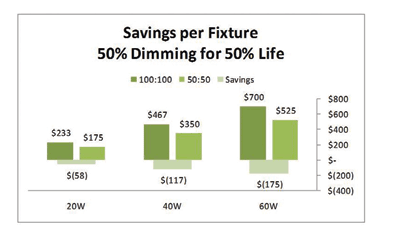LED driver selection for general illumination apps
Advance performance drivers will enable future smarter lighting roadmaps
BY IRENE SIGNORINO
Director of Marketing, Lighting and
Automotive Products
Microsemi
www.microsemi.com
Ongoing advances in LED manufacturing, color-rendering and packaging are delivering considerable advantages for customers in the general illumination market. LEDs promise to deliver substantial savings and enable novel features thanks to their intrinsic advantages over other light sources. They reduce cost of ownership through improved energy efficiency and life expectancy and they provide a more precise way to control and enjoy light. Because of the revolution LEDs have triggered in the general illumination market, those users transitioning to this new light source are also more likely to consider “smarter” fixtures, that is, fixtures that can be integrated into the network, remotely controlled or customizable.
To fulfill any of these promises, however, it is important to realize that while LEDs may be the shiny “hearth” of the fixture and the key reason why an end user chooses the fixture in the first place, the driver is the underlying “brain.” Indeed, the driver is a key component of the fixture that will enable these next-generation, smart-lighting features, including true, nonflickering dimming, color mixing and custom setting, or remote fixture monitoring/management. The full potential of LED technology simply cannot be realized without driver technology that is capable of leveraging the unique characteristics that differentiate LEDs from other traditional light sources. In short, the promise of LED technology will not be met without an optimized LED driver, as a part of a well-engineered system including the LEDs, optics, and heat sink.
Basic driver features
Figure 1 introduces a basic Return On Investment (ROI) model that is representative of a single LED fixture used by the end customer. By conducting sensitivity tests on each variable we will understand what features are worth integrating (and paying for) into the driver according to the specific application.

Fig. 1: ROI of an LED driver system.
Efficiency
Since many customers are adopting LED due to increased efficiency compared to traditional light sources, the LED driver feature undoubtedly most recognized and requested is power conversion efficiency.
The effect on the ROI is easy to calculate at different power levels and different cost of kWh.
First, a 5% efficiency improvement is economically much more rewarding for the consumer at higher power levels. While this is a very easy mathematical calculation the cost associated in providing this improvement at the driver level is often not understood (it usually involves higher grade and more numerous components which are more expensive). It usually makes more sense to pay for this economic premium only at higher power levels, in regions with very high electricity costs or when many fixtures are used.

Fig. 2: Efficiency, power rating, and electricity costs effect on ROI
A second aspect to consider is what exactly the “efficiency” value as found on the power supply manufacturer’s datasheets is. Power conversion efficiency varies according to usage configuration: different input voltages and different loads will result in different efficiency and usually the datasheet will only provide a peak efficiency value. It is the right of customers to initiate a more meaningful conversation with their power supply maker asking for more data in configurations that are representative of his actual applications.
A third consideration is to keep in mind that any power conversion loss will result in heat dissipation. This is important because of its implications on the expected useful life of the driver. Let’s first review the basic concept of mean time between failures (MTBF) and life expectancy and their connection with the driver performance and cost and then tie this with the driver power conversation efficiency.
MTBF and life expectancy
Remembering the common “bath-tub curve” that exemplifies the failure rate of most systems over usage time we understand the concept of MTBF over the course of the system useful life as well as the concept of life expectancy.
The first important note is that these two values are distinct and both critical for the performance of the end fixture and therefore, if not available on the datasheet, it is the right of the customer to ask for and obtain more data through a meaningful conversation with his power supply maker.
The second consideration is that suppliers arrive at these values through a mix of design considerations, careful component selections, reliability models and assumptions as well as actual testing and field data. Confirming the assumptions will enable you to ensure your specific application is covered as well as allow you to compare fairly across suppliers.
Finally you might also want to keep in mind that failure rate decrease (and life expectancy increases) when the power supply is used at less than its rated power and at lower temperature (see Fig. 3 ). It is common to find an indication of hundreds of thousands of hours of MTBF or life expectancy at less than 100% load and low temperatures that are not representative of the actual end application. Please note that the temperature than can be controlled and therefore cited by the supplier is “case” temperature not ambient temperature.

Fig. 3: Load and case temperature effect on MTBF.
Efficiency and lifeexpectancy/MTBF
As mentioned earlier, power losses result in heat generation by the power supply, and this will increase the temperature inside the driver and that of its case and therefore decrease both MTBF and life expectancy.
If the customer is designing a street light which usually needs higher power and require much higher replacement costs, higher reliability, longer life, and higher efficiency should take precedence over the driver price considerations. If conversely the customer is designing a low power residential fixture probably price will be the most important among these parameters.
Dimming
Another approach for improving LED fixture ROI is a driver that enables non flickering and flexible dimming, which saves energy while also enhancing the user experience. A fixture used at 50% of its power for 50% of its life (as an example) can save 25 percent in energy costs at 0.23 kWh/50Kh (see Fig. 4 ). In this example, a user can realize $117 in additional savings by using a 20W rather than 60W fixture, while ensuring the best possible experience for the user.

Fig. 4: Dimming and pPower rRating eEffect on ROI.
Dimming is possibly the most cost effective feature than can be integrated into a driver and a fixture to enable enhanced and possibly automatic energy savings when the fixture is deployed.
Advanced driver features
While the above are nonnegotiable performance features that a driver has to provide there are more advanced capabilities that can be integrated in it to enhance the fixture value.
Remote controls for dimming
Automatic dimming or shut-off (through timers or light sensors or proximity sensors or remote controls units etc) is the next, more complicated implementation of dimming capabilities. There are many options of how this can be achieved and again the driver will play a key role in interfacing with the control protocol of choice. A close partnership between the lighting fixture manufacturer and the power supply manufacturer will ensure a common high performance roadmap achieved in the most cost efficient way for both.
Color maintenance and controls
An even more sophisticated feature than can be enabled in the fixture is the active control of the color and quality of light. The tight control than can be achieved is what makes LED lighting be truly differentiated from earlier light sources, thus enabling new applications in which the user has full control over color mixing, selection and sequencing.
Color controls can have many different level of complexity all appropriate according to the specific application.
A basic color control system might simply consist in “binned” LED (LED carefully selected on specific parameters) paired with a driver that provides a very tight LED current regulation.
A more complex color control system can be achieved either by active mixing of multiple LED colors based on user input or correlation tables or based on active sensing and feedback of system light temperature.
If active color management is important an intelligent LED driver system with integrated color-management control system plays an enormous role in ensuring high color accuracy while meeting color maintenance requirements.
When choosing a color-management system, it is important to understand that LED-based white light can be created either by using phosphor-based white LEDs or by using RGB LEDs. The RGB-based white light can have variable color point, which is particularly beneficial for high-end luminaries and various types of architectural lighting. Figure 5 represents a high-performance, extremely accurate color management system for RGB luminaries that includes an RGB color sensor, a color manager and LED drivers.

Fig. 5: Color management system for RGB luminaries.

Fig. 6: CIE 1931 color matching functions.
Unfortunately, commercially available RGB sensors do not provide these response times. For this reason, Microsemi has developed a special procedure which compensates for the mismatch between RGB color sensor response times and those required by color-matching functions. This is done during the calibration process. The output of color sensor [R, G, B] is sent through low-pass filters (LPF), which are connected to the input of the color manager. The calibration block of the color manager then converts [R, G, B] value of the color sensor to the tristimulus value.
Next, a digital controller compares reference data to measured data and, using a digital proportional integral (PI) algorithm, develops RGB pulse width modulation (PWM) signals for the LED drivers. For higher accuracy, a 12-bit PWM algorithm is used. LED drivers control the luminary RGB LEDs, which the mixed light will represent as a targeted white point temperature. In a sophisticated LED fixture, the color temperature can be changed under the user’s control through a communication protocol such as PLC, DXM412 or DALI. To improve system accuracy, the temperature sensor can be connected to a color manager, which can adjust the influence of the temperature on LED spectral characteristics.
It is clear that there are many considerations and trade-offs the light fixture designers has to consider when designing a product many of which are ultimately determined by the LED driver. A clear understanding of the LED driver performance characteristics as well as a close partnership between LED fixture maker and the LED driver maker will enable good solid products to be released into the market as well as the early definition of advanced performance drivers that will enable future smarter lighting roadmaps ■
Advertisement
Learn more about Microsemi





